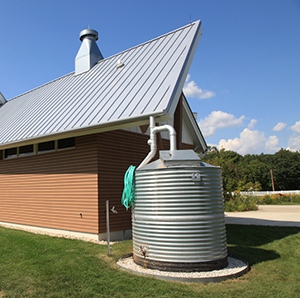 Globally, one out of every five people does not have access to clean water, and water demand is expected to rise 40 percent over the next 20 years. As water use continues to outweigh water resources, water conservation plays a vital role in everyday life. But new tools are available to assist consumers and communities in reducing water stress and conserving the valuable resource.
Globally, one out of every five people does not have access to clean water, and water demand is expected to rise 40 percent over the next 20 years. As water use continues to outweigh water resources, water conservation plays a vital role in everyday life. But new tools are available to assist consumers and communities in reducing water stress and conserving the valuable resource.
Agricultural Radar and Scanning Techniques
A Texas AgriLife Research team is applying two tools to its small grains breeding program in order to identify drought-resistant traits in wheat. Researchers are attempting to use ground-penetrating radar and terrestrial laser-scanning to search for traits that give the wheat’s breeding line a drought-resistance advantage.
“What we are trying to do is apply technology that allows us to see further into characteristic traits than we have been able to with the human eye,” said Sean Thompson, a doctoral student at Texas A&M University working on the Texas AgriLife Research project.
In the past, ground-penetrating radar—designed for the construction industry to detect objects such as electrical lines and pipes below ground—has been used to look at crop-water availability, but never to examine plant populations. The research team hopes it can adapt the technology to look at the roots of wheat as it grows in the field.
The radar can estimate the biomass of roots and differentiate between root systems from various crops. Mapping roots at varying depths helps researchers detect plants with deeper roots or roots that spread further.
“We think these root systems will provide the plant with more water during a drought situation,” Thompson said. “Our idea is if we can identify those plants in a population or be able to characterize the roots below ground, we could adapt our varieties to make them more drought-resistant or drought-tolerant.”
Likewise, researchers plan to use a terrestrial laser scanner to take quick, accurate measurements in wheat fields.
“That’s a much more accurate measurement than we’ve had in the past using a yardstick or ruler,” Thompson said. “Typically we walk through our nurseries looking for characteristics or traits in a plant that give it an advantage over others. We take plant height measurements which can be related to yield or performance, or we take an overall agronomic score.”
Drought tolerant plants help conserve water during dry seasons because farmers can produce crops without relying on irrigation. They also aid farmers in coping with droughts such as the one that gripped much of the United States during the past growing season.
Rainwater Harvesting System
The Texas AgriLife Research and Extension Center has also developed a project that might someday aid communities in conserving water used for landscape irrigation. In the project, researchers collect rainwater from roof space using an internal-pipe rain gutter system. The water is then forced into 3,600-gallon tanks through a gravity-flow system. The collected rainwater is later used to water various types of gardening plots and turf-grass demonstration plots.
“Ultimately, we want to develop a comprehensive small-acreage landowner system where we can show some fruit and nut trees and ways to manage all of that off the natural systems here,” Texas AgriLife irrigation specialist Nich Kenny said. “This year in the midst of a drought, we filled three of these tanks—approximately 9,000 gallons of water— on 6 inches of rainfall. That’s a pretty effective way to capture water.”
Kenny estimates that for every one-inch rainstorm, each square foot of rooftop can collect about .6 gallons of water.
“You can start to add that up on a standard house and basically what you end up with is a whole lot of water that can be stored,” he said. “Next you have to figure out what to do with it.”
Conservation Tools for the Home
Consumers who want to save money on their water bills and promote water conservation can save rainwater without an elaborate rooftop system. Rain barrels not only help conserve water, but promote healthier plants and soil, as well as reduce storm water runoff.
Catching and storing roof water for use in landscaping projects takes advantage of a free source of water while simultaneously reducing sewer overflows and flooding. It also helps recharge the groundwater supply with pure, unpolluted water. Plus, the water collected in the rain barrel provides non-chlorinated water for use lawns and gardens.
Consumers using rain barrels and other conservation methods at home can examine and compare their water usage using an online water calculator. The calculator allows users to compare their water use to a similar average and efficient homes in their regions. It also shows users which home water sources are efficient and which may be wasteful. Plus, it offers other simple conservation tips to help save water and energy.
